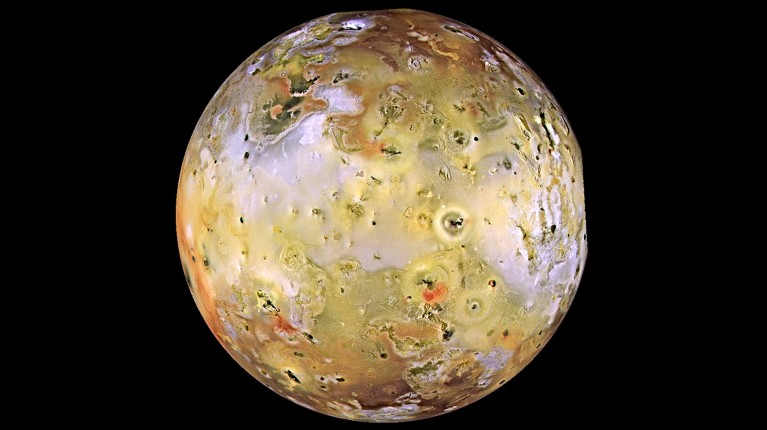Jupiter’s moon Io has been continuously shaped by volcanic activity for billions of years — possibly even for the Solar System’s entire 4.57-billion-year history, a study suggests.
The findings, published in Science on 18 April1, have implications for the search for extraterrestrial life and for the understanding of volcanic moons and planets, including Earth.
Io is the most volcanically active place in the Solar System, with hundreds of volcanoes on its surface. This makes it difficult to study the moon’s past. The moon is continuously resurfaced by the constant flow of runny lava and ash settling from volcanic plumes, obscuring any physical evidence of its history. The volcanic activity arises because Io’s orbit of Jupiter is synchronized with the orbits of two neighbouring moons, Europa and Ganymede. The gravitational interactions between them make Io’s orbit elliptical and periodically squeeze the moon’s centre, causing friction and heating.
Sulfur studies
When Io’s volcanoes erupt, they spew sulfur-rich gases into the atmosphere. The researchers were able to use this sulfur as “a tracer for studying Io’s long-term evolution”, explains Katherine de Kleer, a planetary scientist at the California Institute of Technology in Pasadena and a co-author of the study.
Throughout the Solar System, the ratio between two sulfur isotopes — sulfur-32 and the slightly heavier sulfur-34 — is relatively constant, says de Kleer. Using the Atacama Large Millimeter/submillimeter Array, a radio telescope in Chile, she and her and colleagues measured sulfur emissions in Io’s atmosphere and calculated the ratio between the two isotopes.
Their observations revealed that Io has lost 94–99% of its originally available sulfur. At the top of its atmosphere, the ratio of sulfur isotopes is slightly skewed towards the lighter variant, and these gases rich in sulfur-32 are “being stripped off the top of the atmosphere at a loss of about one tonne per second”, de Kleer says. Over billions of years, this discrepancy has accumulated, and Io’s overall sulfur composition has become heavier. By extrapolating from the current rate at which the lighter sulfur is being lost, the researchers calculated that Io’s volcanoes have been erupting for most of its history.
Implications for Europa
The research also validates models that suggest Io, Europa and Ganymede have been caught in the same orbital dance since the birth of the Solar System, or soon afterwards. This raises the possibility that Europa has been experiencing similar heating for a similar amount of time, says de Kleer. Europa is a promising candidate for a place in the Solar System that has the potential to harbour life. Billions of years of heating “would enhance the habitability of Europa’s subsurface ocean over the long term”.
The very hot, runny lava on Io is much hotter than what found on Earth now, “but it’s thought to be the composition of magma that dominated in Earth’s early history, when we had these huge events laying down big regions of lava flows in a short period of time”, says de Kleer. “Io’s volcanism might be giving us a window into the mechanisms of volcanism and Earth’s early history.”
Jani Radebaugh, a planetary geologist at Brigham Young University in Provo, Utah, welcomes the findings. “That Io could be even more exciting — even more extreme — in its volcanism is mind-blowing,” she says. “The results reveal that further exploration of Io would help us uncover the unknown histories of other volcanic worlds, including our own planet.”


 Jupiter mission will be first to orbit moon of another planet
Jupiter mission will be first to orbit moon of another planet
 The Solar System has a new ocean — it’s buried in a small Saturn moon
The Solar System has a new ocean — it’s buried in a small Saturn moon
 First up-close images of Mars’s little-known moon Deimos
First up-close images of Mars’s little-known moon Deimos



